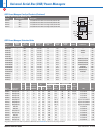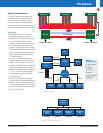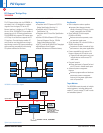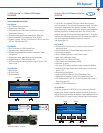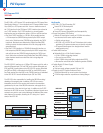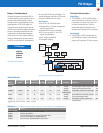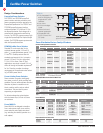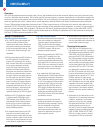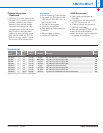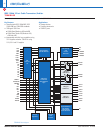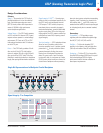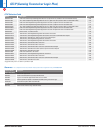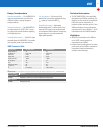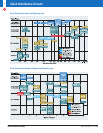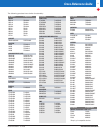
Interface Selection Guide Texas Instruments 4Q 2006
Design Considerations
Physical-Layer Selection Issues
• The 1394 PHY layer should support the
minimum number of nodes or ports
required by the end product. Having two
ports permits spanning to other devices
on the bus through daisy-chaining. Three
or more nodes enable branching or hub
capabilities.
• Will the end product need DC isolation at
the 1394 interface? The cable doesn’t
provide a DC-isolated path from node to
node. In cases where there’s a possibility
for the various equipment connected
across 1394 to be at different ground
potentials or different power domains,
the grounds may need to be isolated from
each other to prevent excessive currents
and noise. However, the ground signal on
the 1394 cable must not be DC-isolated
from the PHY power-distribution ground
plane. Thus when DC isolation between
units is required at the 1394 interface, it
is frequently performed at the PHY- and
link-layer interfaces—often through the
use of special I/O cells that allow for
capacitive coupling of the PHY-link signals.
• While the EIA-775 specification requires
a minimum speed of 200 Mbps at the
1394 interface, using 400-Mbps PHYs is
recommended. Slower nodes present on
the bus can be a source of speed traps.
Almost all 1394 silicon available today is
already 400-Mbps capable.
• The suspend/resume feature of the PHY
layer lets two currently inactive ports
achieve low-power states while maintain
-
ing their connection status. It also permits
them to quickly resume operation as soon
as they detect an applied port bias voltage.
Link-Layer Selection Issues
• What kind of data needs to be transferred?
Some link controllers are designed to
implement specific data protocols over
1394, such as the serial bus protocol
2 (SBP-2) for mass storage or IEC 61883-4
for MPEG-2 transport, and some are
designed as general purpose.
• What is being interfaced to 1394? If the
system has PCI, consider one of the
PCI/OHCI links. Applications involving
streaming compressed audio/video most
likely need a link from the iceLynx family.
Other TI links have interfaces for external
processors/memory or are dedicated for a
peripheral function (camera/storage).
• For audio/visual (A/V) applications,
different types of A/V data require different
formatting and transmission methods on
1394. Specifically identifying which types
of A/V to be supported is fundamental to
choosing the right 1394 chip set for the
digital set-top box (DSTB) or digital TV
(DTV) design. Standards define how to
carry MPEG-2 transport streams in both
digital video broadcasting (DVB) format
and in DirecTV format, which have different
packetization schemes.
• Another aspect of the link layer that
should be considered is the amount of
data-buffer memory supported. Typically,
the more bandwidth an application
requires, or the more simultaneous
isochronous/asynchronous traffic that
needs to be supported, the larger the
buffer memories must be.
• As the number of simultaneous isochro-
nous channels present goes up, or the bit
rate of an individual stream increases, the
receive buffer needs to be larger.
Technical Information
• 1394-1995 is an IEEE designation for a
high-performance serial bus. A revision to
this standard has been published as IEEE
1394a-2000, and clarifies and adds to
portions of the IEEE 1394-1995 standard.
The 1394b standard increases the speed
of 1394 to 800, 1600 and 3200 Mbps, as
well as providing new connection options
such as plastic optical fiber (POF), glass
optical fiber (GOF) and UTP-5. This serial
bus defines both a backplane (for exam-
ple, VME, FB+) physical layer and a point-
to-point, cable-connected virtual bus. The
backplane version operates at 12.5, 25 or
50 Mbps, whereas the cable version
supports data rates of 100, 200, 400, 800
and 1,600 Mbps across the cable medium
supported in the current standard. Both
versions are totally compatible at the link
layer and above. The interface standard
defines transmission method, media and
protocol.
• Applications of the cable version are the
integration of I/O connectivity of personal
computers, peripherals, and consumer
electronics using a low-cost, scalable,
high-speed serial interface. The 1394
standard provides services such as
real-time I/O and live connect/disconnect
capability for devices including storage
(HDD, CD-ROM, CDRW, MO, ZIP, RAID,
SAN, etc.), printers, scanners, cameras,
set-top boxes, HDTVs and camcorders.
O
verview
IEEE 1394 high-speed interconnection enables simple, low-cost, high-bandwidth real-time data connectivity between many types of electronic equip-
m
ent. As a multimedia network standard, 1394 is ideally suited for consumer electronics, computers and peripherals. It is also ideal for situations that
benefit from true peer-to-peer operation and maximum flexibility. 1394 is self-configuring, has strong power management/distribution capabilities and
r
obust error-detection that make it a leading choice in control applications, especially those that also need to accommodate streaming multimedia.
The new 1394b technology enables higher performance (up to 3.2 Gbps), longer distance (up to 100 meters) and a variety of cable media to fit any
application (STP, UTP, POF and GOF), making it ideal for home networking and high-speed data transfer applications. For example, in long-haul applica-
tions such as home networking, 1394b is capable of 100 Mbps over 100 meters of unshielded twisted pair Category 5 cable (called CAT5 or UTP5).
For high-speed applications, TI offers a 1394b chip set that enable speeds up to 800 Mbps for applications such as video-on-demand or backing up a
RAID array. TI 1394b is backward compatible to 1394a.
36
1394 (FireWire
®
)
➔



